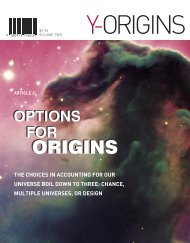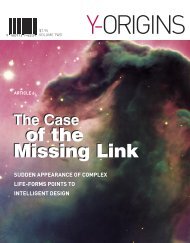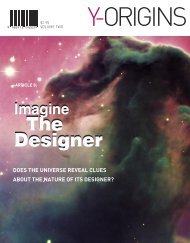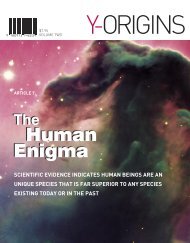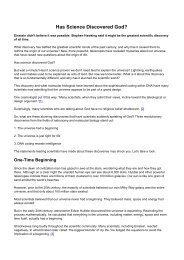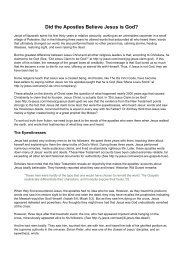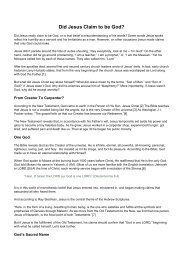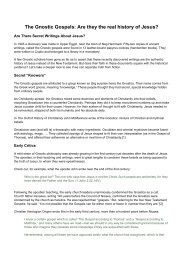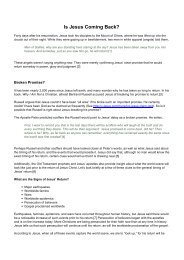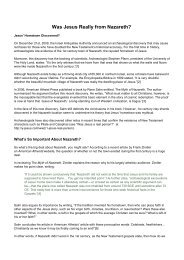Odds2
You also want an ePaper? Increase the reach of your titles
YUMPU automatically turns print PDFs into web optimized ePapers that Google loves.
6. Space-energy density. The spaceenergy<br />
density of the universe requires<br />
much greater precision than the mass<br />
density. For physical life to be possible,<br />
it must be fine-tuned to one part in<br />
10 120 . 10<br />
According to the big bang theory, all of this<br />
minute fine-tuning was programmed into<br />
the initial conditions of the first microsecond<br />
of the explosion that began our<br />
universe. At that instant the rate and ratios<br />
of expansion, mass, density, antimatter,<br />
matter, etc., were set in place, eventually<br />
leading to a habitable planet called Earth.<br />
In addition to the 35 different characteristics<br />
of our universe that must be just right<br />
for life to exist, our galaxy, solar system,<br />
and planet also needed to be exceptionally<br />
fine-tuned or we would not be here. 11<br />
A FINELY TUNED GALAXY<br />
Galaxies are formations of from millions to<br />
perhaps a trillion stars. Our own galaxy is<br />
called the Milky Way. It’s unknown how<br />
many galaxies the universe contains, but it<br />
may be around a trillion. Surprisingly, given<br />
the great number of these star groups, most<br />
galaxies are incompatible with life.<br />
In order for life to exist in a galaxy, it needs<br />
to meet several criteria. 12 The following are<br />
just three of the fine-tuned characteristics a<br />
galaxy needs to support life:<br />
Shape of the galaxy. The Milky Way is spiralshaped.<br />
Of the three types of galaxies—elliptical,<br />
irregular, and spiral— the spiral type is<br />
most capable of hosting human life.<br />
Not too large a galaxy. Our Milky Way<br />
is enormous, measuring 100,000 lightyears<br />
from end to end. However, if it<br />
were just a bit larger, too much radiation<br />
and too many gravitational disturbances<br />
would prohibit life like ours.<br />
Not too small a galaxy. On the other<br />
hand, a stable Earth orbit that is necessary<br />
for life could not exist if our galaxy<br />
were slightly smaller. And a smaller galaxy<br />
would result in inadequate heavy<br />
elements, such as iron and carbon,<br />
essential to life.<br />
Our Milky Way galaxy meets these and many<br />
other conditions essential for life. Most of the<br />
others do not.<br />
When we focus in even closer, on our own<br />
star and its planets, the odds for life being<br />
possible become even more extreme.<br />
A FINELY TUNED<br />
SOLAR SYSTEM<br />
Copernicus’s theory that Earth revolved<br />
around the Sun, seemed to relegate our<br />
planet to an ordinary status in the universe.<br />
However, if Earth was the center<br />
of our solar system, as Ptolemy and 16th<br />
century Catholic Church leaders had<br />
taught, we wouldn’t be here. None of<br />
them, including Copernicus, knew that in<br />
order for human life to be possible, Earth<br />
needs to revolve around a Sun that has<br />
just the right size, location, and conditions<br />
as ours does.<br />
But that is not all. We need other planets<br />
such as Jupiter and Mars to act as defense<br />
shields, protecting us from a potential<br />
catastrophic bombardment of comets and<br />
meteors. We also need a moon of just the<br />
right size and position to impact our tides<br />
and seasons. Let’s take a look at just a few<br />
of the many conditions in our solar system<br />
that are just right for life.<br />
The Sun’s distance from the center<br />
of the galaxy. Our Sun is positioned<br />
thousands of light-years from the center<br />
of the Milky Way, near one of its spiral<br />
arms. 13 This is the safest part of the<br />
galaxy, away from its highly radioactive<br />
center.<br />
The Sun’s mass not too large. If the<br />
mass of the Sun were a small percentage<br />
greater, it would burn too quickly<br />
and erratically to support life.<br />
The Sun’s mass not too small. On the<br />
other hand, if it were smaller, its greater<br />
flaring would disrupt Earth’s rotation<br />
rate.<br />
The Sun’s metal content. Only two percent<br />
of all stars have enough metal content<br />
to form planets. Too much metal<br />
in a star will allow too many planets to<br />
form, creating chaos. Our Sun has just<br />
the right amount of metal for planets to<br />
form safely.<br />
Effect of the Moon. The Moon stabilizes<br />
the Earth’s tilt and is responsible for<br />
our seasons. If it weren’t there, our tilt<br />
could swing widely over a large range,<br />
making our winters a hundred degrees<br />
colder and our summers a hundred<br />
degrees warmer.<br />
When astronomers consider our remarkable<br />
solar system, they acknowledge that if it<br />
was slightly different, advanced biologi-<br />
8• WHAT ARE THE ODDS • ARTICLE 2



